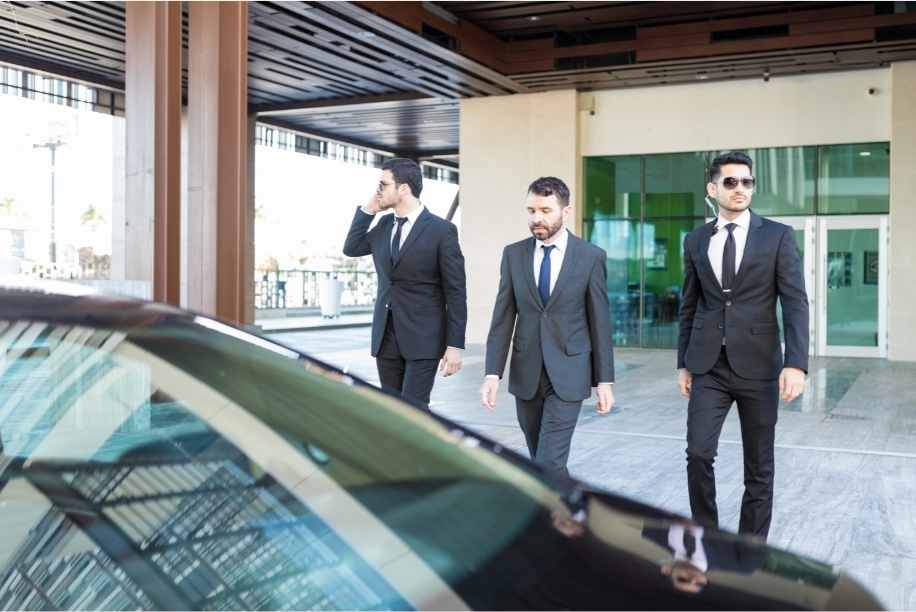June 8, 2021
Basic tactics on VIP protection
At the Chivalry Group, we have extensive experience in VIP Protection, dealing with the world’s leading corporate, musical, entertainment, private, sports, and diplomatic figures.
Our experiences, working in New Zealand and Australia as well as overseas mean that we have extensive knowledge of the tactics required to protect VIP from all backgrounds and in all situations.
Our VIP Protection Security services are bespoke and unique to each client and to each situation. There are, however, basic tactics that are deployed no matter the client or the location and these underlying tactics form the basis of our security planning for any close protection operation.
Planning phase
Planning underpins all VIP protection work and establishes the strategies and tactics that will need to be deployed that are specific to each individual job.
During the planning phase, an operational plan specific to the bespoke job will be formalised. This will typically include input from advance officers and the team leader. Depending on the location of the job, the team leader may liaise with security contacts in the host country and rehearsals will also take place during the planning phase to account for all potential threats.

The operational plan will include a detailed schedule of all timings and contingencies for each phase of the operation, as well as emergency actions, contingency planning, communications schedules and contact details for all relevant personnel. It will also detail all relevant potential requirements from logistics to emergency services such as police and medical and through to the personal needs of the client.
As well as carrying out a detailed threat assessment and intelligence to inform the operational plan, the plan will also typically include mobile protection planning which takes into consideration all travel plans, the vehicles in the convoy, the drivers and the arrival and departure times from all venues including back up and alternate options. Other inclusions will be all protection work carried out on foot, where direct intervention may be required rather than the use of a vehicle.
Operational phase
The operational phase of VIP protection can be broken into three areas, two of which have already been mentioned in the planning phase:
- Direct protection phase – where the client receives close protection on foot e.g. collection from the airport, movement towards or from the accompanying convoy and walking to subsequent venues.
- Mobile protection phase – this is where the client is travelling by vehicle, possibly in a convoy.
- Static protection phase – where a client is either at a venue, residence or temporary place of accommodation.
Direct protection phase

The aim in this phase is to eliminate or reduce the opportunity for attack during movement by foot, by using individual skills, team skills and formations to place human barriers between the client and a potential attacker or the means by which an attack could be delivered. Close protection officers must be prepared for immediate extraction should it be required to prevent additional attacks from taking place.
Threats during this phase have an increased impact as there is no protection from vehicles or perimeter walls – a client will typically be at their most exposed during this phase and it is harder for protection officers to mitigate against the threat of explosive devices or weapons being used.
The tactics and protocols used during this and any phase are tied to the threat assessment and environmental factors and risk profile.
During this phase, close protection officers are also at their most visible and their conduct must be beyond reproach.
Mobile protection phase

Mobile protection refers to an extensive range of available counter-measures, applied during movement by vehicle of the client between venues, to mitigate a perceived or actual threat. The threat may be from terrorists, criminals, politically disruptive groups, fixated persons, self-publicists and lone adventurers.
As well as the potential threats from terrorists and criminals, clients are also vulnerable to the normal hazards of travelling by road during the mobile protection phase.
The choice of driver and skill level of that driver is an important consideration during the planning phases and whether overt or covert, the driver of vehicles involved in the protection of VIPs must always drive in accordance with the type and level of training they have received and remain responsible for the driving decisions they make. Being completely aware of your vehicle and how to use it becomes critical.
Static protection phase
The static protection phase has become more important in recent times following a number of incidents across the world of VIPs and diplomats being targeted in static locations, often their own homes.
This reality has led security professionals and agencies to increase awareness and introduce effective counter-measures such as personal protection, restricted access and other routine search regimes in order to secure static premises.
A key requirement during this phase is the proper application of risk management together with sound, well thought out, and effective protection methods and principles.
Other tactics deployed in VIP protection
As well as these tactics deployed during the key phases of planning and operations, there are a number of supporting tactics we deploy in order to offer the highest level of security for all VIPs. These include:
- Information gathering – part of the planning phase, our team conduct in-depth information gathering on the client and the proposed itinerary in order to identify any and all potential threats.
- Liaison – every VIP protection job involves liaison whether that’s with local law enforcement, media, travel agencies, local security, airports and more. An important part of the work we do is to nurture strong relationships with all key stakeholders and ensure we create a smooth operational plan.
- Reconnaissance – The aim of reconnaissance is to gain a thorough tactical appreciation of the area of operations, its inherent strengths, and vulnerabilities. Maps and plans, no matter how detailed, will not reveal the extent to which a venue is overlooked by surrounding buildings, or trees that obstruct the view into or from a venue in different seasons.
Post deployment phase
A key tactic in any VIP protection operation is to carry out a full post-deployment debrief involving the entire team. At this phase, we will study incident and post-operation reviews to extract any lessons learned for future operations and take forward any best practices.
Who we work with
Our VIP Protection Security team have worked with some of the world’s leading figures from all walks of life – from leading sports stars to diplomats and musical icons. Our VIP protection services are wide and varying and we often work closely with executive assistants to arrange complete protection from the airport gate, to media liaison, and large scale security coordination.
With over 100 years of experience in our executive team, we provide tailored VIP protection security that is discreet and above all, confidential.
We have offices in New Zealand and Australia combining strategic partnerships and team resources in all corners of the globe. Talk to the team today about your VIP Protection needs.
Need Security? We Can Help
Copyright © 2020 The Chivalry Group All Rights Reserved
